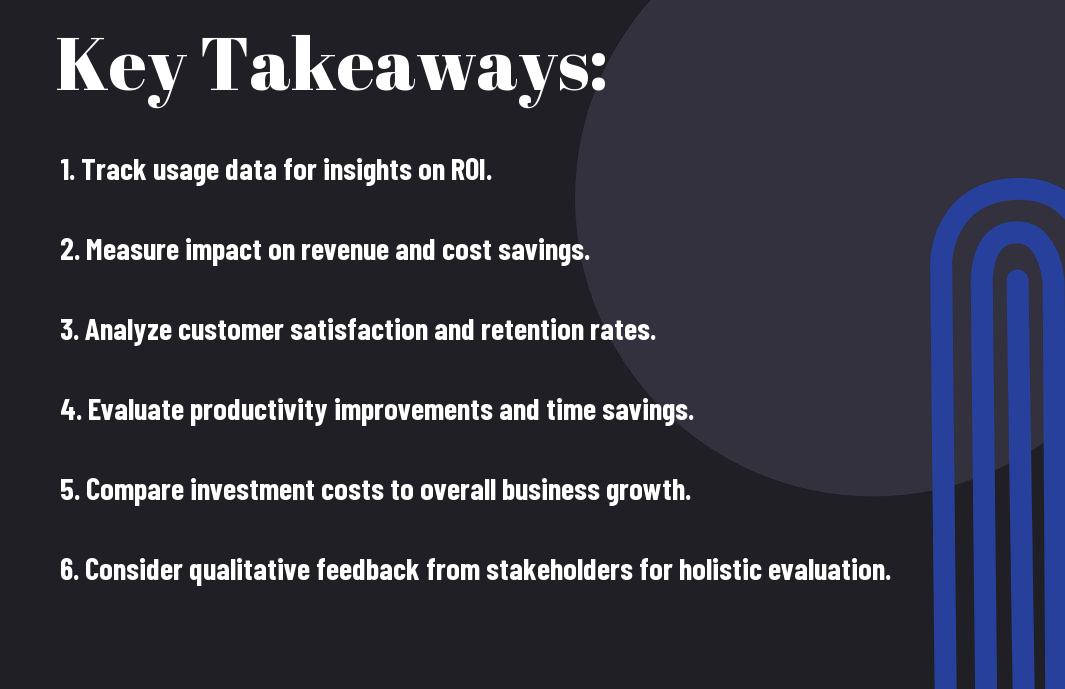Many businesses invest in software services to streamline operations and boost productivity. To determine if these investments are yielding positive returns, you need to measure the return on investment (ROI) of your software services. By analyzing key metrics such as cost savings, efficiency improvements, revenue growth, and customer satisfaction, you can quantify the benefits of your software investments and make informed decisions about future technology investments.
Key Takeaways:
- Define clear objectives: Before implementing software services, businesses should clearly define their objectives and key performance indicators (KPIs) to measure ROI effectively.
- Track metrics and analyze data: Businesses can measure ROI by tracking relevant metrics such as cost savings, improved efficiency, increased revenue, and customer satisfaction. Analyzing this data can help in determining the impact of software services on the bottom line.
- Compare before and after implementation: To measure the ROI of software services, businesses should compare performance metrics before and after implementation. This comparison can help in quantifying the benefits and success of the software services.


Defining ROI in Software Services
What is ROI?
An vital concept for businesses to understand is Return on Investment (ROI) – a key performance indicator that evaluates the financial benefit of an investment relative to its cost. In software services, ROI plays a crucial role in determining the effectiveness of technologies and solutions implemented within a company.
Why Measure ROI in Software Services?
On your journey to optimizing business processes and enhancing operational efficiency, measuring ROI in software services is paramount. By assessing the returns generated from your software investments against the initial expenditure, you gain valuable insights into the impact of these technologies on your bottom line.
Software services encompass a wide array of tools and platforms that can automate tasks, streamline workflows, and boost productivity within your organization. Identifying the ROI of these services allows you to make informed decisions about future investments, prioritize projects, and allocate resources effectively.
Identifying Key Performance Indicators (KPIs)
Financial KPIs
Some of the important key performance indicators (KPIs) that you can use to measure the return on investment (ROI) of software services are financial metrics. These metrics include revenue growth, cost savings, and profitability. By tracking revenue growth, you can determine how the software service has contributed to increasing your company’s income. Cost savings measure the efficiencies gained from using the software, such as reduced labor costs or lower operational expenses. Lastly, profitability indicators show how the software has impacted your bottom line.
Operational KPIs
On the operational side, KPIs such as efficiency improvements, resource utilization, and process automation can help you assess the impact of software services on your day-to-day operations. Efficiency improvements measure how the software has enhanced productivity and streamlined workflows within your business. Resource utilization metrics reflect how effectively your company is utilizing its resources with the help of the software. Process automation indicators demonstrate the extent to which manual tasks have been automated, leading to time and cost savings.
To effectively assess the performance of your software services, you need to consider a combination of financial, operational, and customer-centric KPIs.
Customer-Centric KPIs
Some customer-centric KPIs that you should focus on include customer satisfaction, retention rates, and acquisition costs. Operational KPIs are important for understanding how efficiently your software is running, but customer-centric KPIs are crucial for determining the software’s impact on your customer relationships. Customer satisfaction metrics gauge how happy your customers are with the software and its services. Retention rates indicate the ability of the software to keep customers engaged and loyal over time. Acquisition costs measure the expenses associated with acquiring new customers through the software platform.
For instance, tracking customer satisfaction levels can help you identify areas for improvement in your software services, leading to higher customer retention rates and ultimately increased ROI.
Calculating ROI for Software Services
The ROI Formula
Software services can have a significant impact on your business, but how do you measure that impact? Calculating Return on Investment (ROI) is a useful tool for assessing the value that software services bring to your organization. The ROI formula is a simple yet powerful way to determine the profitability of an investment. It is calculated by subtracting the initial cost of the investment from the net gain, then dividing that number by the cost of the investment.
Example Calculations
Software services can be a substantial investment, so understanding how to calculate the ROI is crucial. For example, if you invest in a project management software that costs $10,000 and it helps you save $30,000 in operational costs annually, your ROI would be calculated as follows: ($30,000 – $10,000) / $10,000 = 2, or 200%. This means that for every dollar you invest in the software, you get $2 back in return.
Plus, it’s vital to consider the intangible benefits of software services, such as improved efficiency, better decision-making, and enhanced customer satisfaction. These factors can also contribute to the overall ROI of the investment.
Common Challenges in ROI Calculation
On the road to calculating ROI for software services, you may encounter challenges such as accurately measuring the benefits, determining the appropriate timeframe for analysis, and accounting for opportunity costs. These challenges can make it difficult to get a precise ROI figure, but with careful consideration and strategic planning, you can overcome them.
Another important factor to consider is the potential risks associated with software services, such as implementation delays, integration issues, and changes in technology. Understanding and addressing these risks can help you make more informed decisions and achieve a higher ROI in the long run.
Data Collection and Analysis
Now, if you’re wondering how to measure the return on investment (ROI) of software services for your business, head over to How to Measure Software ROI For SaaS Products to get detailed insights on this topic.
Sources of Data
Any business seeking to measure the ROI of software services needs to gather data from various sources. These sources can include user feedback, customer surveys, usage analytics, financial reports, and more. By collecting information from these diverse channels, you can gain a comprehensive understanding of how the software is impacting your business’s bottom line.
Data Analysis Techniques
Analysis is key to interpreting the data collected effectively. You can utilize techniques such as cohort analysis, segmentation, A/B testing, and regression analysis to explore deep into the numbers and derive meaningful insights. These techniques help you identify trends, patterns, and correlations that can inform decision-making and optimize the ROI of your software investments.
It’s necessary to combine qualitative and quantitative analysis to paint a holistic picture of how the software services are contributing to your business’s success.
Tools for Data Analysis
Tools such as Google Analytics, Mixpanel, Tableau, and more can aid in the analysis of data collected from software services. These tools offer features for visualization, reporting, and advanced analytics that can streamline the process of ROI measurement. By leveraging these tools, you can efficiently analyze large datasets and extract actionable insights to drive strategic decisions for your business.
Data analysis tools are constantly evolving, so staying updated on the latest technologies and platforms can help you stay ahead in measuring and optimizing the ROI of your software services.
Interpreting ROI Results
What Do ROI Results Mean?
Keep in mind that ROI results are not just numbers on a spreadsheet. They provide a deeper understanding of the value your business is getting from its software services. A positive ROI indicates that your investments are yielding returns, while a negative ROI suggests that adjustments may be needed in your strategy or utilization of software services.
Identifying Areas for Improvement
Results can help you pinpoint specific areas where your software services may not be delivering the expected returns. By analyzing the ROI data, you can identify inefficiencies, underutilized tools, or areas where additional training or resources are needed to improve overall performance.
For instance, if the ROI analysis shows that certain software features are not being used to their full potential, you can take steps to train your employees on how to leverage these tools more effectively, ultimately increasing the value derived from your software investments.
Setting Targets for Future ROI
To improve your ROI over time, it’s crucial to set targets based on your current results. By establishing clear goals for ROI improvement, you can work towards maximizing the value of your software services and optimizing their impact on your business operations. Regularly monitoring and adjusting these targets will help ensure continuous growth and success.
Understanding the patterns and trends in your ROI data can also help you forecast future returns, enabling you to make informed decisions about resource allocation and strategic investments in software services.

Best Practices for Measuring ROI
Once again, understanding how to measure the return on investment (ROI) of software services is crucial for your business. To grasp the concept better, it’s imperative to review resources like Return on Investment Meaning and Calculation Formulas, which can provide valuable insights into calculating ROI accurately.
Regularly Review and Refine KPIs
Practices like regularly reviewing and refining Key Performance Indicators (KPIs) are imperative. KPIs help you gauge the effectiveness of your software services in achieving business goals. By consistently evaluating and adjusting these indicators, you can ensure that your ROI measurements remain relevant and aligned with your objectives.
Involve Stakeholders in ROI Measurement
Stakeholders play a vital role in measuring ROI for software services. By involving key stakeholders from various departments or teams, you can gather diverse perspectives on the impact of these services. Their input can provide a comprehensive view of how software investments are contributing to different areas of the business, facilitating more accurate ROI assessments.
Plus, engaging stakeholders fosters a sense of ownership and accountability, encouraging collaboration towards maximizing the ROI of software services. It also promotes transparency and communication within the organization, creating a more informed and invested team.
Consider Both Quantitative and Qualitative Metrics
Measuring the ROI of software services goes beyond just numbers. The effectiveness of these services can be evaluated through both quantitative data, such as cost savings or revenue growth, and qualitative measures like user satisfaction and productivity improvements.
The inclusion of qualitative metrics provides a more holistic view of the impact of software services on your business operations and employee experiences. By considering both quantitative and qualitative aspects, you gain a more comprehensive understanding of the overall ROI of your software investments.
Summing up
Following this guide on how to measure the ROI of software services, you now understand the importance of aligning your business goals with the measurement of software investments. By identifying key performance indicators, setting clear objectives, and utilizing tools like ROI calculators, you can effectively track the success and impact of your software services on your business.
For further insight into measuring the ROI of custom software projects, check out ➤ How To Measure The ROI Of A Custom Software Project💡. By implementing these strategies and approaches, you can make more informed decisions about your software investments, ultimately driving growth and success for your business.
FAQ
Q: How can businesses measure the return on investment (ROI) of software services?
A: Businesses can measure the ROI of software services by analyzing the increase in productivity, cost savings, revenue growth, and customer satisfaction resulting from the use of the software. They can also track key performance indicators (KPIs) such as user adoption rates, time saved on tasks, and efficiency improvements to quantify the impact of the software on their operations.
Q: What are some key metrics businesses can use to assess the ROI of software services?
A: Some key metrics businesses can use to assess the ROI of software services include return on assets (ROA), return on equity (ROE), net present value (NPV), internal rate of return (IRR), payback period, and customer lifetime value (CLV). By tracking these metrics before and after implementing a software service, businesses can determine the financial benefits and effectiveness of the investment.
Q: How can businesses ensure an accurate measurement of the ROI of software services?
A: To ensure an accurate measurement of the ROI of software services, businesses should establish clear objectives and KPIs before implementing the software. They should regularly track and analyze performance data to evaluate the impact of the software on their operations. It is also important to consider both qualitative and quantitative factors when assessing ROI, such as improved employee satisfaction, reduced errors, and enhanced decision-making capabilities.



